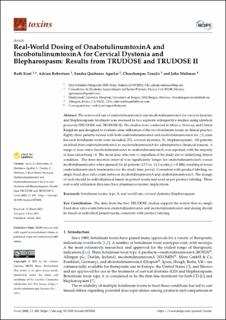| dc.contributor.author | Kent, Ruth | |
| dc.contributor.author | Robertson, Adrian | |
| dc.contributor.author | Quiñones Aguilar, Sandra | |
| dc.contributor.author | Tzoulis, Charalampos | |
| dc.contributor.author | Maltman, John | |
| dc.date.accessioned | 2022-04-01T10:47:49Z | |
| dc.date.available | 2022-04-01T10:47:49Z | |
| dc.date.created | 2022-02-21T13:00:24Z | |
| dc.date.issued | 2021 | |
| dc.identifier.issn | 2072-6651 | |
| dc.identifier.uri | https://hdl.handle.net/11250/2989228 | |
| dc.description.abstract | The real-world use of onabotulinumtoxinA and incobotulinumtoxinA for cervical dystonia and blepharospasm treatment was assessed in two separate retrospective studies using identical protocols (TRUDOSE and TRUDOSE II). The studies were conducted in Mexico, Norway, and United Kingdom and designed to evaluate dose utilization of the two botulinum toxins in clinical practice. Eighty-three patients treated with both onabotulinumtoxinA and incobotulinumtoxinA for ≥2 years for each botulinum toxin were included, (52, cervical dystonia; 31, blepharospasm). All patients switched from onabotulinumtoxinA to incobotulinumtoxinA for administrative/financial reasons. A range of dose ratios (incobotulinumtoxinA to onabotulinumtoxinA) was reported; with the majority of dose ratios being >1. The mean dose ratio was >1 regardless of the study site or underlying clinical condition. The inter-injection interval was significantly longer for onabotulinumtoxinA versus incobotulinumtoxinA when assessed for all patients (15.5 vs. 14.3 weeks; p = 0.006), resulting in fewer onabotulinumtoxinA treatments over the study time period. Consistent with product labeling, no single fixed-dose ratio exists between incobotulinumtoxinA and onabotulinumtoxinA. The dosage of each should be individualized based on patient needs and used as per product labeling. These real-world utilization data may have pharmacoeconomic implications. | en_US |
| dc.language.iso | eng | en_US |
| dc.publisher | MDPI | en_US |
| dc.rights | Navngivelse 4.0 Internasjonal | * |
| dc.rights.uri | http://creativecommons.org/licenses/by/4.0/deed.no | * |
| dc.title | Real-World Dosing of OnabotulinumtoxinA and IncobotulinumtoxinA for Cervical Dystonia and Blepharospasm: Results from TRUDOSE and TRUDOSE II | en_US |
| dc.type | Journal article | en_US |
| dc.type | Peer reviewed | en_US |
| dc.description.version | publishedVersion | en_US |
| dc.rights.holder | Copyright 2021 by the authors | en_US |
| dc.source.articlenumber | 488 | en_US |
| cristin.ispublished | true | |
| cristin.fulltext | original | |
| cristin.qualitycode | 1 | |
| dc.identifier.doi | 10.3390/toxins13070488 | |
| dc.identifier.cristin | 2004086 | |
| dc.source.journal | Toxins | en_US |
| dc.identifier.citation | Toxins. 2021, 13 (7), 488. | en_US |
| dc.source.volume | 13 | en_US |
| dc.source.issue | 7 | en_US |

